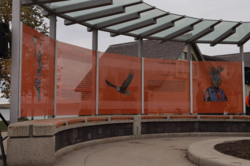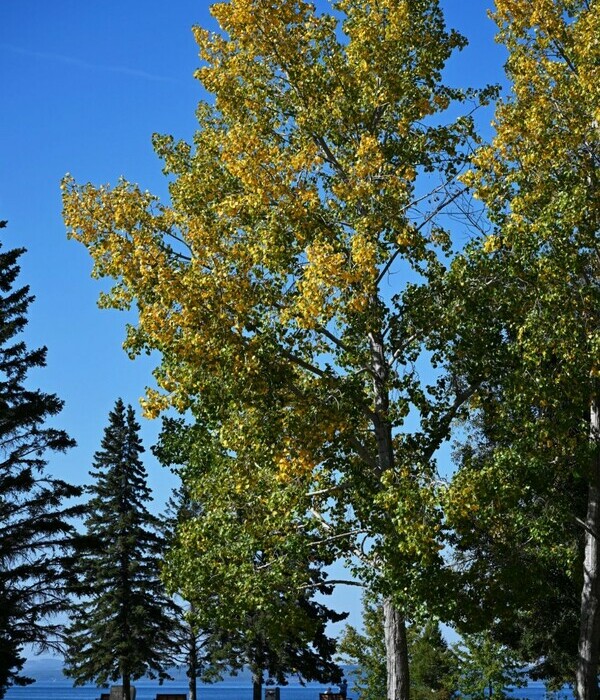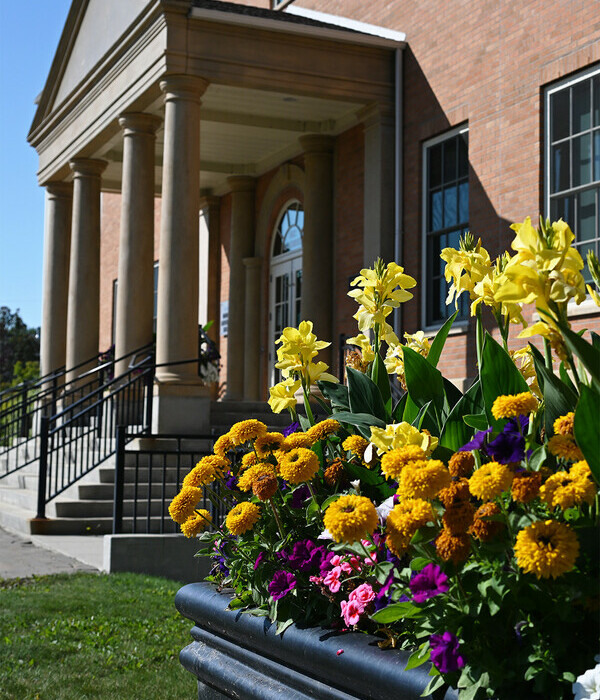The Sylvan Lake region is rich in its culture and history, and has a thriving art scene. The Town of Sylvan Lake's Cultural Master Plan aims to bring this rich history and culture to life, for all to enjoy. See ongoing culture projects, programs, and opportunities below!
The Town of Sylvan Lake respectfully acknowledges that the land on which we gather is Treaty 6 territory, home to the Métis Nation of Alberta, Region 3. These lands are traditional meeting grounds, gathering places, and travel routes for many Nations, including the Cree, Dene, Blackfoot, Métis, Saulteaux, and Nakota Sioux. We are grateful for the Traditional Knowledge Keepers and Elders who are still with us today and those who have gone before us. We acknowledge and thank all the many First Nations, Métis, and Inuit whose footsteps have marked these lands for centuries.
Truth and Reconciliation

In 2021 the Town of Sylvan Lake commissioned an Indigenous Mural. We dedicated this mural to our Indigenous community, and as a step forward towards the reconciliation process. At the dedication ceremony, we heard from the Mayor, Councilor Teresa Rilling, artist Ryan Jason Allen Willert, and more. For more information please see this article in the Sylvan Lake News
Mural Location
-
Lakeshore Drive and 44 Street
-
At the circular benches in the park
Phyllis Webstad Story – How Orange Shirt Day Started
University of Alberta – Indigenous Canada: Free Course
- Explore Indigenous histories and contemporary issues in Canada. From an Indigenous perspective, this course explores key issues facing Indigenous peoples today from a historical and critical perspective highlighting national and local Indigenous-settler relations. Topics for the 12 lessons include the fur trade and other exchange relationships, land claims and environmental impacts, legal systems and rights, political conflicts and alliances, Indigenous political activism, and contemporary Indigenous life, art and its expressions.
- Free University Course
Summary of the Final Report of the Truth and Reconciliation Commission of Canada
- The Truth and Reconciliation Commission of Canada was established in 2008 under the terms of the Indian Residential Schools Settlement Agreement. The Commission was mandated to:
- reveal to Canadians the complex truth about the history and the ongoing legacy of the church-run residential schools, and
- guide and inspire a process of truth and healing, leading toward reconciliation within Aboriginal families, and between Aboriginal peoples and non-Aboriginal communities, churches, governments, and Canadians generally. The process was to work to renew relationships on a basis of inclusion, mutual understanding, and respect.
- From the report, “As Canadians, we share a responsibility to look after each other and acknowledge the pain and suffering that our diverse societies have endured—a pain that has been handed down to the next generations. We need to right those wrongs, heal together, and create a new future that honours the unique gifts of our children and grandchildren … We invite you to search in your own traditions and beliefs, and those of your ancestors, to find these core values that create a peaceful harmonious society and a healthy earth.”
- Learn all about what the Truth and Reconcilliation Commission found, and about what reconciliation means!
- Find the report here: Honouring the Truth, Reconciling for the Future (click continue to publication if a message appears)
Yearly update from the Yellowhead Institute
- Since 2019 the Yellowhead Institute has been producing a yearly report on the status of reconciliation.
Learn how you can make a difference today. Remember, learning is a process that takes time and reflection!
Truth and Reconciliation Calls to Action
- Read the full Calls to Action document
- Copies are available at the Municipal Government Building and at the Community Centre
For Kids: Learn the History of Truth and Reconciliation
- For kids in grades 5 - 12, this workbook teaches about residential schools, Treaties, and the historic and current relationships between Indigenous and non-Indigenous peoples.
- Do you need counselling support to deal with the impact of Residential School in your life? Call the Indian Residential School Survivors Society - British Columbia 24/7 Emergency Crisis line: 1 800 721 0066
- Red Deer Native Friendship Society
4808 51 Avenue, Red Deer, AB, T4N 4H3
403 340 0020 - Rocky Mountain House Native Friendship Centre
4917 52 St CL, Rocky Mountain House AB T4T 1E5
403 845 2788
Red Dress Day is a National Day of Awareness for Missing and Murdered Indigenous Women, Girls, and Two-Spirit People (MMIWG2S+).
Inspired by Métis artist Jaime Black’s Red Dress Project, red dresses are hung in public and private spaces to remind us of the lives stolen—independent women, mothers, daughters, aunties, sisters, and friends whose voices were silenced far too soon.
These are not just statistics—they are our loved ones, our communities, our stories.
Take action:
- Wear red on May 5 and share why
- Hang a red dress in your home, yard, or office window
- Organize or attend a local walk, vigil, or event
- Learn and share the 231 Calls for Justice from the Final Report of the National Inquiry
- Use the hashtags #RedDressDay and #MMIWG2S to amplify Indigenous voices and raise awareness
The Moose Hide Campaign is a movement that began with a father and daughter and has grown into a national call to action to end violence against women and children.
Wearing a small piece of moose hide (or its digital version) symbolizes a personal commitment to creating safer spaces and healthy relationships rooted in respect.
Ending violence starts with accountability, conversations, and with choices we make every day.
Take action:
- Pick up a moose hide pin available at Town facilities including the NexSource Centre, Wellness & Community Connections Centre, and the Municipal Government Building
- Wear it proudly on May 15 and beyond
- Register and take part in the National Campaign Day on May 15, which includes livestreams, ceremonies, workshops, and fasting
- Donate to the campaign
- Have a conversation—start with one. The ripple matters
Cultural Projects
Call to Artists and Artisans
2025 Art Show & Sale Coming Soon!
Artists and Artisans are asked to contact Mr. Tom Bradshaw MFA, Culture Coordinator at tbradshaw@sylvanlake.ca for more information or a submission package.
Help us build Soap Box Derby Culture in Sylvan Lake. Build a car and feel the rush of gravity powered racing. Join us during 1913 Days to test your car.
Here are some guides for building your racer.
For the young racers we suggest this Stock Car Design
For older racers we suggest this Masters Car Design
If you would like an easier and less expensive build try the Easy Soap Box Design
The Town of Sylvan Lake is dedicated to planning, acquiring, and installing public art pieces. If you would like to be added to our artist list for future projects please contact Tom Bradshaw, Culture Coordinator with samples of your work at tbradshaw@sylvanlake.ca
A pocket park was developed on Centennial (50th) Street within downtown as a place for events, workshops, relaxing or meeting friends, taking lunch breaks, etc.
This amazing initiative is all thanks to the Property Owner, Waterfront Commercial District (WCD), IMPACT Youth Group and the Town of Sylvan Lake Department Teams.
Artist Alley is a unique opportunity for local artists to showcase their work on alleyway back doors throughout Sylvan Lake's downtown. The project was initiated in September 2020 with the following artists located behind the Lakeland Plaza building (50a Street/Lakeshore Drive).
- Aaron Garand
- Denise Milne
- Tina St. Pierre
- Bruno Vista
- Meghan Harkins
- Lisa Thomson
- Ryan Jason Allen Willert
- Jessica Semenoff
- Raevyn Berg
- Larry Reese
Walking Tours
By 1913, the year that Sylvan Lake became a village, Alberta’s most popular beach town was already a summer destination for visitors from across the province. Families owned and rented cottages, sailed in regattas, dove off two 500-foot wooden piers and swooshed down a 16-foot playground slide installed in the shallow waters between. Grab a historical walking map and take a fascinating tour through more than one hundred years of local history.
The romantic stone castle
The old stone castle on 50A St is a highlight of the tour. Built by hand by the Archambeaus in about 1905 – newlyweds from France carrying a shadowy tale of royal banishment and the triumph of true love. The couple hand-collected rocks from the lake to build their dream house – in the likeness of her father’s castle in southern France. Over the years, the Archambeaus added a cement house next to the castle (keeping sheep and goats in the castle, as one does), plus a grocery, dining room, dance hall, post office and the community’s first newspaper.
More sweet highlights
Be sure to search for another of the town’s oldest buildings, the stone house on 46 Ave and the town’s first gas station, the Balmore service station and tea room, built on the lakefront in 1933. Here is a hint: it is where Big Moo is now! (Have a double scoop waffle cone for us!)
Come walk with us. Our Self-guided art walk booklet is available for download.
Art Programs
Check out our recreation, art, and culture program schedule, and register online.
Community programs and events are also available within our Community Program Guide.
Art Instructors wanted
Are you an instructor looking for an opportunity to share your passion?
We're always looking for instructors to lead our recreation and cultural programming, be it sewing, drama, dance, pottery, or sport.
Contact our Recreation and Culture Programming Coordinator at 403 887 2199.
We're Social
Follow us on Facebook, and stay up-to-date on all recreation, art, and culture program opportunities.



